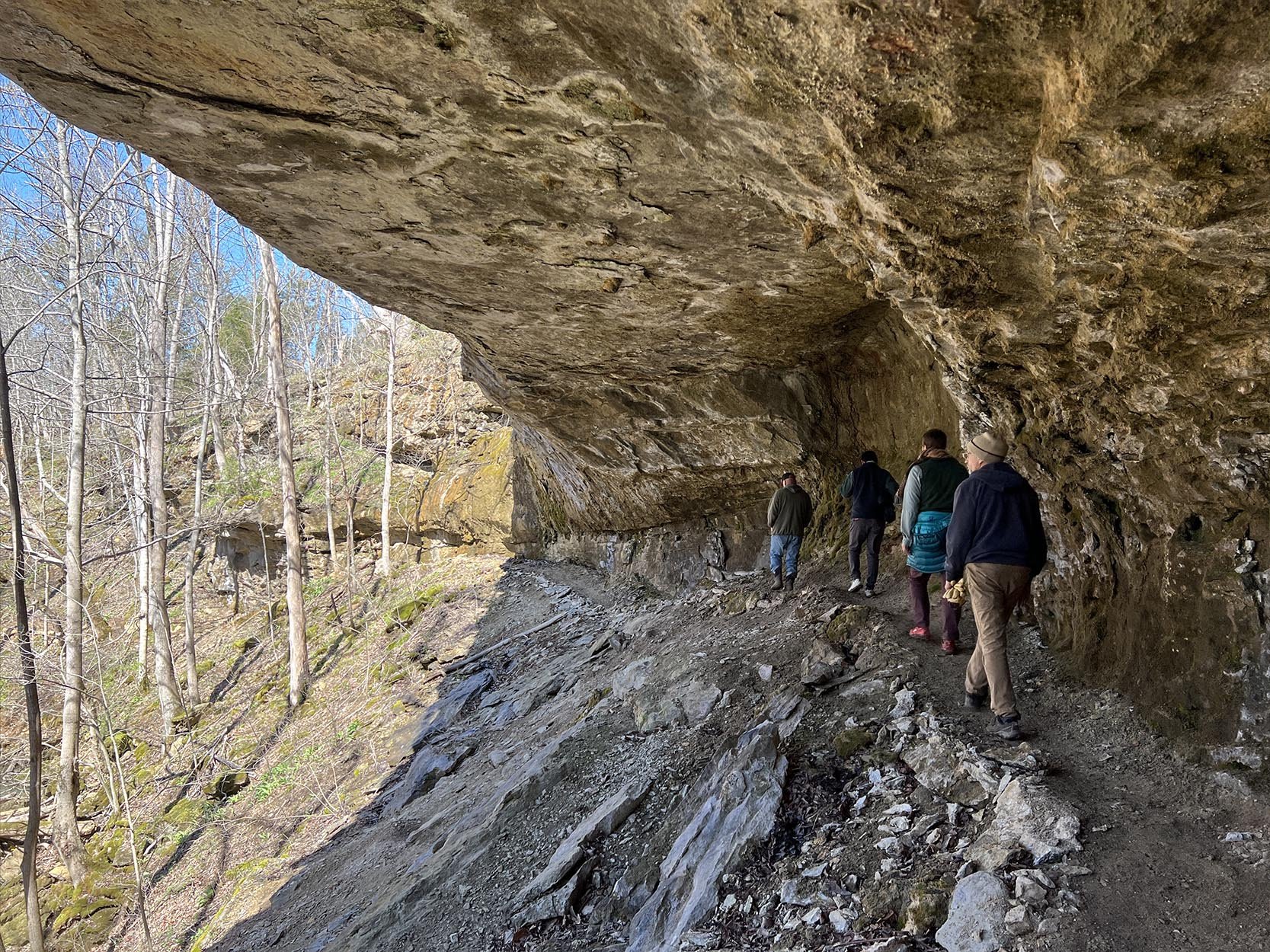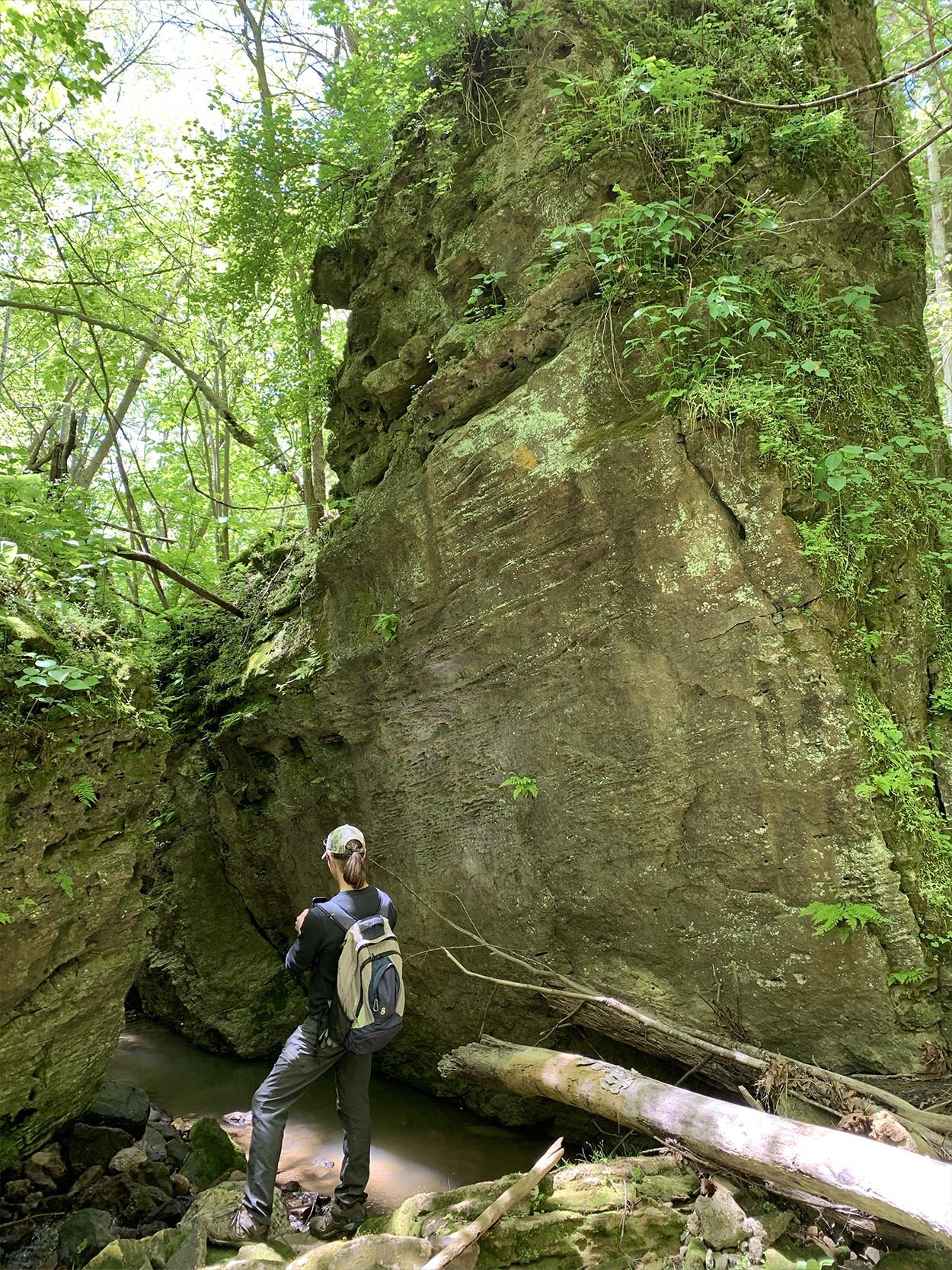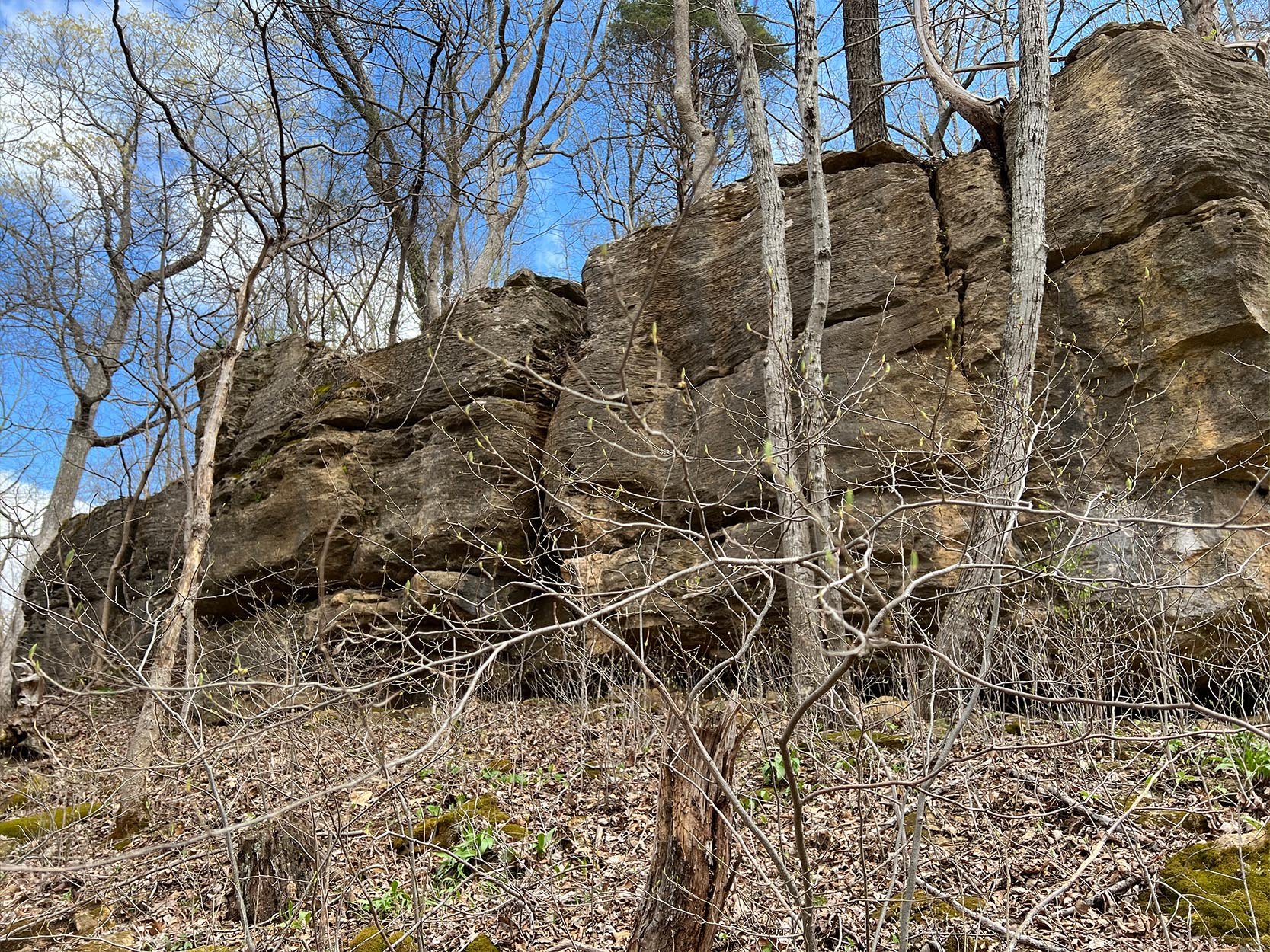Quiverheart Gorge
Quiverheart Gorge. A 99-acre preserve located in Adams County, Ohio. Quiverheart Gorge protects an astonishingly deep dolomite gorge in northwestern Adams County in a region better known for its rolling short grass prairies than its deep valleys. The fact that this gorge is an unexpected landscape feature makes it all the more remarkable and treasured. During the rainy season, Quiverheart has the largest and most beautiful waterfall in the Arc of Appalachia preserve system. The rock formations of Quiverheart are diverse and varied, providing hikers with dramatic scenery around every corner.
HIKING ACCESS BY PERMIT ONLY - SEE LINK BELOW
Beginning on August 18, 2025
Dogs are not permitted at Quiverheart Gorge.
A dog owner's guide to hiking the Arc of Appalachia
A note on ticks & chiggers














Visiting Quiverheart Gorge
How the Permit System Works. A link to the permit application can be found at the bottom of this webpage. If the vehicle limit has not yet been reached on your requested date and you don’t exceed one application per month, your permit will be approved. The emailed permit package will include a two-page hiking guide with preserve regulations, natural history, a trail map, directions, and a passcode to the entrance gate. Please note that the gate will be locked upon your arrival. After you open the lock with the passcode, be sure to shut and lock the gate behind you - both when you enter and when you depart. Please read the following orientation material before applying for a permit. Permit holders violating Arc regulations will be denied future permits and they risk getting their car towed.
Permit Maximum. A maximum of five people are permitted per vehicle, and a total of 10 cars are permitted each day. Permits for multiple cars are not permitted, and each applicant may only submit one permit request in any one month. This policy will allow more visitors to witness the preserve’s outstanding beauty, which is our highest goal. If you wish to bring an organized group too large to apply through this system, please inquire with our office staff on how to proceed. Call 937-365-1935 or write to arcpreserveinfo@gmail.com.
Why does Quiverheart Gorge have limited access? Over the past year, caretakers and visitors have seen a rise in harmful activities at Quiverheart Gorge, including off-trail hiking, trespassing, collecting wildflowers and fossils, and climbing on the waterfall and boulders. These actions damage fragile habitats and can put visitors at risk. A permit system helps protect the preserve by limiting daily visitors, ensuring people agree to the rules before they arrive, and holding them more accountable. While the Arc hoped to avoid this step, the growing impact on the Gorge’s rare and beautiful features made it necessary.
How far in advance can I apply for a permit? Permit applications run in monthly cycles, and each cycle begins anew on the first Wednesday of the month. You can only apply for a permit in the current calendar month. If interested in applying for a permit for a future month, please wait for your desired month to arrive to submit your application.
How long do I have to wait to receive my emailed permit? So long as your application is for a date that is still available, and so long as you haven’t exceeded one application in that month, you will receive your permit in just minutes.
Is there a fee for a permit? No, permits are free. However, stewarding our preserves and maintaining 80 miles of public trails is an expensive proposition for our nonprofit, the Arc of Appalachia. Because the Arc is not tax-supported, we are entirely dependent on donations to keep Quiverheart Gorge and our other preserves open to the public. We would greatly appreciate your gift of support.
Arc regulations can be summarized as follows: Remain on trails at all times and walk in single file to protect the bulbs of native wildflowers bordering the trail - bulbs that are very vulnerable to soil compaction. Do not disturb, pick, or collect flowers, plants, rocks, or wildlife. Hunting, caving, fishing, trail biking, rock climbing, wading, campfires, and swimming are prohibited. Sorry, dogs are not permitted in this delicate landscape.
Hiking Trail Difficulty – Quiverheart’s trails are moderately difficult. The two trails have been carefully constructed to provide a walking surface that is as level as possible, and a route that is assisted with bridges and steps. However, Quiverheart's terrain is naturally rocky, uneven, and steep, and the trail has many ascents and descents. This trail could be difficult for people with limited flexibility and strength. Safety Note: Trails have several creek crossings improved with either stepping stones or bridges that will be underwater during unusually high rains. Consider recent rainfall accumulations before planning a trip. Trails at Quiverheart border dangerous, potentially life-threatening cliffs: Trails can be narrow, uneven, and steep, with some unimproved creek crossings. It is important to stay strictly on the trail and be sure to keep children close at hand.
Quiverheart Gorge Trail Descriptions:
Quiverheart Falls Trail - 2.0-mile loop trail - The Quiverheart Falls Trail winds between the canyon floor and the upper rim of the gorge, offering hikers a variety of extremely dramatic landscapes. Memorable scenery includes a strikingly beautiful waterfall, especially during the rainy season, a canyon floor densely covered with spring wildflowers, steep-sided gorge walls strewn with slump blocks, and a hillside of fallen rocks known as Boulder City. The trail also travels beneath a large rock shelter and along the cedar-clad rim of the canyon. From the bluffs, hikers can admire the beauty of distant forest-clad hills and the deep shadow-filled valley of Bundle Run below.
Whispering Fern Trail - 1.25 miles loop trail- requires hiking the 2.0-mile Quiverheart Falls Trail to access for a total hiking length of 3.25 miles. - The Whispering Fern Trail extends the hiker's downstream journey along Bundle Run and into a remote side tributary. The trail travels below the cliff face, where more beautiful rock formations can be admired, and also follows the stream winding its way along the canyon floor. Spring ephemeral wildflowers grow in rich densities along sections of the wooded trail. Near Bundle Run proper are small cedar openings where remnants of a world-endangered plant and animal community grow - an ecosystem known as an Alkaline Short-grass Prairie, or simply, Cedar Barrens. Here one can see interesting wildflowers in the spring, such as Shooting Stars; and rare prairie wildflowers in August.
Natural History. The bedrock of Quiverheart creates a compelling karst-country landscape of cliffs, springs, seeps, grottos, and sinkholes. The bedrock type is dolomite, a type of limestone that has high concentrations of both calcium and magnesium. Tall vertical walls tower above one’s head and huge dolomite boulders tilt at odd angles at the floor of the narrow canyon. High above the gorge is a rim of sentinel rock walls. Covering the fallen rocks in the sheltered, humid depths of the canyon are carpets of liverworts, columbine, miterwort, two kinds of trillium, abundant ferns, and thick cushions of moss. Where Bundle Run widens out into a floodplain, small patches of the globally rare natural community known as alkaline short-grass prairie persist. This plant community is almost entirely restricted in Ohio to Adams County. Look for such species as prairie dock, little bluestem, pale spiked lobelia, summer bluets, whorled rosinweed, and grey-headed coneflower.
Preserve history: Quiverheart Preserve came to life in 2022 through the vision and generosity of its owners, David and Kim Baker. Their dream was to see their 150-acre farm permanently protected and shared with the public. Partnering with the Arc of Appalachia, they provided the match for a Clean Ohio grant that purchased the 100-acre gorge, pledged their remaining land and home through a future bequest, created an endowment for local tax reimbursement, and volunteered as caretakers.
Quiverheart’s beauty draws many visitors, but its story runs deep. Once the site of the first steam-powered iron blast furnace west of the Appalachians (1815), the land bustled with industry before falling silent and rewilding over two centuries. David and Kim have worked tirelessly to remove invasive plants and restore its native habitats.
The preserve’s name comes from David’s late son, Matthew, who once said riding horses made his “heart quiver.” After Matthew’s passing at age 16, David sought a way to honor him for generations to come. Quiverheart Preserve is that living legacy—a place where nature heals and memories endure.


